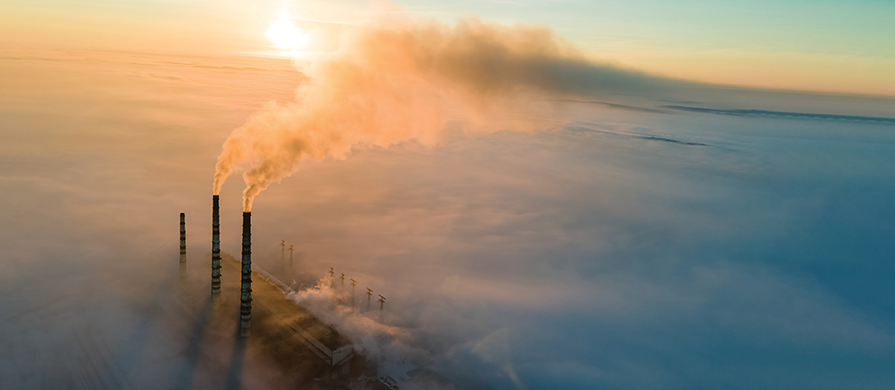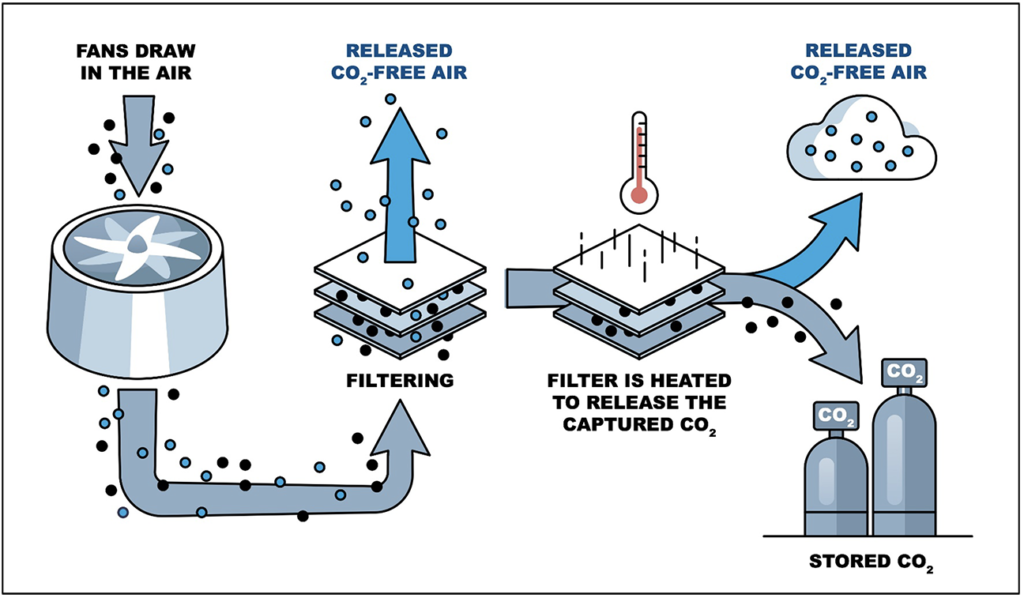
November 28, 2022
Overview of Carbon Capture, Utilization, and Sequestration Projects: Direct Air Capture
This is the third post in a six-part series that discusses carbon capture, utilization, and sequestration. The series covers topics including: industry background; market overview and drivers; past, current, and planned industrial carbon capture projects; and overviews of typical CO2 capture technologies.
As of February 2022, there are approximately 27 operational carbon capture projects globally, with 13 in the U.S.1 Several more projects are planned or underway, with more than 50 projects planned for the coming years.2 This post discusses several representative examples of direct air capture (DAC) carbon capture projects.
In DAC systems, CO2 is captured directly from the atmosphere, which is approximately 420 parts per million by volume (ppmv), or 0.04%, CO2. The captured CO2 is then typically compressed to its supercritical state for use in enhanced oil recovery (EOR) operations and/or for long-term sequestration. Figure 1 below shows a simplified process flow diagram for a typical DAC system. The technical details of the process will be discussed in a future Long International blog post.
Figure 1: Simplified Direct Air Capture Process Flow Diagram

Representative examples of direct air capture CO2 projects are discussed below.
- Occidental Petroleum has recently announced that it is planning to spend up to US$1 billion to install a large DAC system, capable of capturing up to one million tonnes of CO2 per year, in the Permian Basin. Occidental Petroleum further announced that it had reached an agreement with Airbus to sell 400,000 carbon credits3 associated with the facility.4,5 Additionally, Occidental Petroleum plans to develop three carbon sequestration hubs that will be online by 2025 and another 69 smaller DAC facilities by 2035.6,7 1PointFive, a subsidiary of Occidental Petroleum, recently announced that it had entered into a lease agreement for approximately 27,000 acres in Louisiana and that it now has the rights to develop and operate a carbon sequestration hub in the state.8
- Carbon Engineering, a leading DAC company from Canada, is operating a demonstration DAC plant in Canada. It is also working with 1PointFive and Occidental Petroleum on Occidental’s aforementioned DAC facility in the Permian Basin. Additionally, Carbon Engineering is partnering with Storegga on a DAC facility in Scotland that will be designed to remove between 0.5 million and 1.0 million tonnes of CO2 from the atmosphere annually.9
- Climeworks, a leading DAC company from Switzerland, is currently operating a demonstration plant, known as Orca, in Iceland, that captures approximately 4,000 tonnes of CO2 per year, although operating costs are estimated to be as high as US$700 to US$900 per tonne. Climeworks expects costs to drop significantly, to the US$100 to US$200 range, as it ramps up to a one-million-tonne-per-year facility in 2028.10
- CarbonCapture, Inc., has announced plans for the largest carbon capture facility in the world in Wyoming. CarbonCapture’s Project Bison is expected to be operational by late 2023 and will ramp up to capture five million tonnes of CO2 annually by 2030. Wyoming was chosen as Project Bison’s location due to the state’s extensive supply of carbon-free energy sources and favorable operating and regulatory conditions for carbon storage.11
- The U.S. DOE recently announced that it will spend US$3.5 billion, which was allocated for DAC in the 2021 infrastructure law, in years 2022–2026 to fund four DAC facilities spread across the U.S. Each of the DAC facilities will have the capacity to capture and store one million tonnes of CO2 per year, with construction planned to start in 2026 and operations planned to begin by 2029. The DOE indicated it would like two of the four DAC facilities to be placed in regions that are currently producing fossil fuels, and to have all four of the units placed in areas with high potential for geologic CO2 storage.12,13
As detailed above, there are several DAC projects worldwide that are in operation or planned in the coming years. Subsequent blog posts on this topic will discuss current and planned industrial carbon capture projects and provide overviews of typical carbon capture technologies.
1 Dayen, Dimitry, “Carbon Capture: Early Days of a $1 Trillion Industry?” ClearBridge Investments, February 22, 2022. Accessed September 20, 2022. https://www.clearbridge.com/perspectives/institutional/2022/carbon-capture-early-days-of-a-usd1-trillion-industry.
2 Norton, Kit, “Fueling Carbon Capture In the Oil Industry: Production, Net Zero And ESG,” Investor’s Business Daily, July 29, 2022. Accessed October 2, 2022. https://www.investors.com/news/carbon-capture-oil-industry-production-net-zero-esg/.
3 The carbon market is largely driven by the sale and/or trading of carbon credits, where one carbon credit represents the sequestration of one metric tonne of CO2. See previous Long International blog post “Carbon Capture – A Capital-Intensive Technology with Large Growth Potential” for details.
4 Valle, Sabrina, “Occidental signs four-year deal with jet-maker Airbus for carbon credits,” Reuters, March 17, 2022. Accessed September 20, 2022. https://www.reuters.com/business/sustainable-business/occidental-signs-four-year-deal-with-jet-maker-airbus-carbon-credits-2022-03-17/.
5 Norton, Kit, “Fueling Carbon Capture in the Oil Industry.”
6 Norton, Kit, “Fueling Carbon Capture in the Oil Industry.”
7 Valle, Sabrina, “Occidental plans up to $1 bln for facility to capture carbon from air,” Reuters, March 23, 2022. Accessed October 2, 2022. https://www.reuters.com/business/energy/occidental-plans-275-million-2022-carbon-capture-projects-2022-03-23/.
8 Norton, Kit, “Fueling Carbon Capture in the Oil Industry.”
9 Dayen, Dimitry, “Carbon Capture: Early Days of a $1 Trillion Industry?”
10 Dayen, “Carbon Capture: Early Days of a $1 Trillion Industry?”
11 Tamim, Baba, “World’s largest carbon removal facility could suck up 5 million metric tonnes of CO2 yearly,” Interesting Engineering, September 16, 2022. Accessed October 2, 2022. https://interestingengineering.com/innovation/worlds-largest-carbon-removal-facility.
12 “Biden Administration Launches $3.5 Billion Program To Capture Carbon Pollution From The Air,” U.S. Department of Energy, May 19, 2022. Accessed October 2, 2022. https://www.energy.gov/articles/biden-administration-launches-35-billion-program-capture-carbon-pollution-air-0.
13 Timmer, John. “Biden administration lays out plan for four carbon-capture facilities,” Ars Technica, May 21, 2022. Accessed September 20, 2022. https://arstechnica.com/science/2022/05/biden-administration-lays-out-plan-for-four-carbon-capture-facilities/.
ADDITIONAL RESOURCES

Blog
Discover industry insights on construction disputes and claims, project management, risk analysis, and more.
MORE

Articles
Articles by our engineering and construction claims experts cover topics ranging from acceleration to why claims occur.
MORE

Publications
We are committed to sharing industry knowledge through publication of our books and presentations.
MORE
Recommended Reads
Carbon Capture – A Capital-Intensive Technology with Large Growth Potential
This is the first post in a six-part series that discusses carbon capture, utilization, and sequestration.
READ
Overview of Carbon Capture, Utilization, and Sequestration Projects: Post-Combustion Capture
This is the second post in a six-part series that discusses carbon capture, utilization, and sequestration.
READ
Construction Claim Types for Contractors
U.S. federal and state courts recognize 19 basic construction claim entitlements for a contractor’s recovery of damages. This post is the first of a series discussing each of these 19 types.
READ

